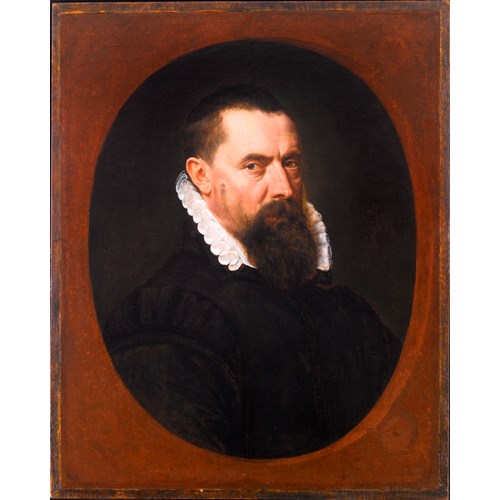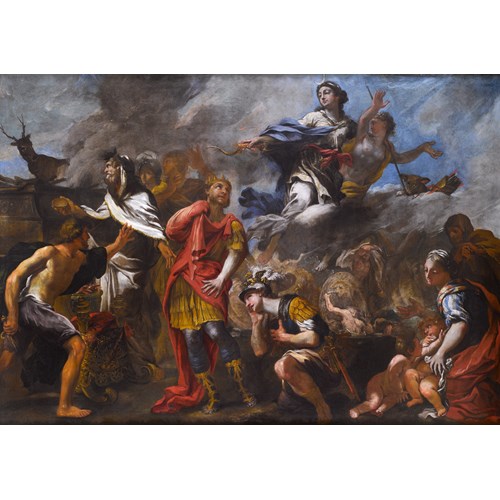Marketplace
A Gypsy Encampment
Rudolf Kazimirovich Zhukovsky
A Gypsy Encampment
Epoque 1850-1900, 19th century
Origine Russia
Medium Oil on canvas
Dimension 33 x 45.7 cm (13 x 18 inches)
In clamorous throng the gypsies wander.
Tonight they spread their tattered tents
encamped beside the river yonder,
Gay is their camp, like freedom gay...
- Alexander Pushkin, The Gypsies (1824)
Rudolf Kazimirovich Zhukovsky's work, A Gypsy Encampment, was a common subject of Romantic Russian and European painting of the nineteenth century, as well as poetry like Pushkin's quoted above. Gypsies were seen as the very epitome of freedom, a nomadic community apparently beyond the periphery of conventional social order. The gypsy acts as an anti-bourgeois motif, suggesting the alternative lifestyle which would eventually be encompassed within the notion of Bohemianism within the avant-garde creative community in the romantic nineteenth century. Central to Zhukovsky’s treatment of this subject is the exoticism of the central figures; in the foreground a dark-skinned laughing Madonna-like figure looks out of the picture in a challenging manner, meeting the eye of the viewer, behind her musicians play and people dance wildly. It has been suggested that the figure towards the far right, wearing a brimmed hat and red tie, could be a self-portrait of Zhukovsky, as he is looking on and sketching the scene with a companion by his side, see detail below. They stand out in the scene as being of a similarly conservative appearance, which contrasts to the others, especially the wild-haired piper to the left.
Prior to establishing his career as an artist and illustrator, in 1835, Zhukovsky gained a second silver medal, followed by the title of ‘Free Artist’ four years later. Zhukovsky’s work was reproduced in the journal Peterburgsky Sbornik (Petersburg Collection), published by N. Nekrasov (St. Petersburg, 1846) it also published works by V.G. Belinsky, V.F. Odoevsky, and Dostoevsky. In his critical review of the Peterburgsky Sbornik, F.V. Bulgarin stated that the authors were striving to confine to Nikolai Gogol’s literary principles of the ‘natural school’. Belinsky took up the name imparting a positive connotation to it and viewed the natural school as in opposition to the ‘false’ and ‘rhetoric’. Significant to the associated artists and writers was the literary influence of Dostoevsky, whose novel Poor Folk was published in the Peterburgsky Sbornik (1846).
Zhukovsky’s work adheres to the ideas of the ‘natural school’. After the 1840s, the middle classes in Russia became a significant consumer of the arts and the general orientation of culture changed noticeably in correspondence with its tastes. Writers began to concentrate their attention on the facts of daily life, previously deemed insignificant, and instead on the difficult existence of the poorest and previously un-noticed citizens. This literary tendency, the ‘natural school’, arose in Russia under the influence of the 1830s French genre of the psychological sketch, which described daily life and its citizens. So, the natural school had an immense influence on the future development of the Russian artistic mentality and its depiction of St. Petersburg. In relation to the latter, Zhukovsky’s illustrations were also used for the publication The Physiology of Petersburg (1845), this contained works of noted Russian writers under Nikolay Nekrasov’s editorship.
Tonight they spread their tattered tents
encamped beside the river yonder,
Gay is their camp, like freedom gay...
- Alexander Pushkin, The Gypsies (1824)
Rudolf Kazimirovich Zhukovsky's work, A Gypsy Encampment, was a common subject of Romantic Russian and European painting of the nineteenth century, as well as poetry like Pushkin's quoted above. Gypsies were seen as the very epitome of freedom, a nomadic community apparently beyond the periphery of conventional social order. The gypsy acts as an anti-bourgeois motif, suggesting the alternative lifestyle which would eventually be encompassed within the notion of Bohemianism within the avant-garde creative community in the romantic nineteenth century. Central to Zhukovsky’s treatment of this subject is the exoticism of the central figures; in the foreground a dark-skinned laughing Madonna-like figure looks out of the picture in a challenging manner, meeting the eye of the viewer, behind her musicians play and people dance wildly. It has been suggested that the figure towards the far right, wearing a brimmed hat and red tie, could be a self-portrait of Zhukovsky, as he is looking on and sketching the scene with a companion by his side, see detail below. They stand out in the scene as being of a similarly conservative appearance, which contrasts to the others, especially the wild-haired piper to the left.
Prior to establishing his career as an artist and illustrator, in 1835, Zhukovsky gained a second silver medal, followed by the title of ‘Free Artist’ four years later. Zhukovsky’s work was reproduced in the journal Peterburgsky Sbornik (Petersburg Collection), published by N. Nekrasov (St. Petersburg, 1846) it also published works by V.G. Belinsky, V.F. Odoevsky, and Dostoevsky. In his critical review of the Peterburgsky Sbornik, F.V. Bulgarin stated that the authors were striving to confine to Nikolai Gogol’s literary principles of the ‘natural school’. Belinsky took up the name imparting a positive connotation to it and viewed the natural school as in opposition to the ‘false’ and ‘rhetoric’. Significant to the associated artists and writers was the literary influence of Dostoevsky, whose novel Poor Folk was published in the Peterburgsky Sbornik (1846).
Zhukovsky’s work adheres to the ideas of the ‘natural school’. After the 1840s, the middle classes in Russia became a significant consumer of the arts and the general orientation of culture changed noticeably in correspondence with its tastes. Writers began to concentrate their attention on the facts of daily life, previously deemed insignificant, and instead on the difficult existence of the poorest and previously un-noticed citizens. This literary tendency, the ‘natural school’, arose in Russia under the influence of the 1830s French genre of the psychological sketch, which described daily life and its citizens. So, the natural school had an immense influence on the future development of the Russian artistic mentality and its depiction of St. Petersburg. In relation to the latter, Zhukovsky’s illustrations were also used for the publication The Physiology of Petersburg (1845), this contained works of noted Russian writers under Nikolay Nekrasov’s editorship.
Epoque: 1850-1900, 19th century
Origine: Russia
Medium: Oil on canvas
Signature: Signed in Cyrillic (lower left).
Dimension: 33 x 45.7 cm (13 x 18 inches)
Plus d'œuvres d'art de la Galerie









